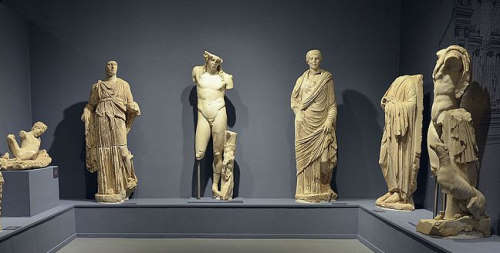The ancient city of Ephesus, located near Selçuk in modern-day Turkey, is known as a significant archaeological site with a history spanning thousands of years. Excavations in this ancient city have shed light on Ephesus’ rich past, bringing its historical layers to the surface. This article combines information from various sources to provide a comprehensive overview of the excavations in Ephesus.
Early Excavations and Discoveries
The initial aim of the excavations at the ruins of Ephesus was to locate the Temple of Artemis. Sponsored by the British Museum, the first excavation efforts were led by architect John Turtle Wood in 1863. Although they reached the marble coverings of the temple in 1869, the anticipated remains were not found, leading to a halt in the excavations in 1874.
In 1895, Karl Mautner Ritter von Markhof’s donation enabled the resumption of the excavations. These efforts were led by Otto Benndorf, a professor of classical archaeology at the University of Vienna and the first president of the Austrian Archaeological Institute. The artifacts discovered during this period are housed in the Ephesus Museum in Vienna. Artifacts found after 1906 were left in Turkey and are displayed in the Selçuk Museum and the ancient city of Ephesus.
Modern Period Excavations and Significant Discoveries
Excavation work continued under the leadership of the Austrian Archaeological Institute President and excavation director Dr. Sabine Ladstätter and her team until 2016. The general survey project of the theater, completed in the 2010 season, was approved within the same season by the relevant committee. This project set the principles for the theater’s restoration, and implementation work continues accordingly.
The excavations led by Dr. Sabine Ladstätter resumed in 2022 after a temporary halt in 2016 by the Turkish Ministry of Culture and Tourism.
Historical and Cultural Significance of Ephesus
Ephesus holds immense importance with its 5000-year history. The initial archaeological research was started by British engineer J.T. Wood in 1869, followed by D.G. Hogarth from the British Museum in 1904. The Austrian Archaeological Institute has been involved in the excavations since 1895, led by Otto Benndorf. The Austrians only paused their work during the First and Second World Wars. Since 1954, excavation work has been carried out by both Austrian and Ephesus Museum archaeologists. Despite over a century of work, only about 10% of Ephesus has been unearthed.
Major Discoveries and Restoration Efforts
Among the sensational findings from the early years of the excavation is the Parthian Frieze, unearthed in 1903. Depicting the Roman victory over the Parthians (161-165 AD), this frieze is one of the most important Roman-era reliefs in Anatolia. However, this magnificent piece still resides in the Ephesus Museum in Vienna. The policy of keeping findings in Turkey was established after 1906, leading to the discovery of early Christian sites such as the Church of Mary and the Basilica of St. John. The excavation of Curetes Street in the 1950s marked the beginning of Ephesus as a major tourist attraction.
The first restoration and conservation efforts, conducted on behalf of the Austrian Academy of Sciences, were carried out at the Temple of Hadrian under the direction of Franz Miltner and Fritz Eichler. The famous Artemis statue was also rediscovered during this period. The luxurious Roman Terrace Houses, known as the Terraced or Slope Houses, were excavated in the 1960s and opened to visitors in 2006 after being protected by a modern roof structure. The restoration of the magnificent Library of Celsus was completed in 1978 after a decade of work.
UNESCO World Heritage and Current Efforts
In 2015, Ephesus was inscribed on the UNESCO World Heritage List, recognized as an outstanding example of a settlement shaped by Hellenistic, Roman, Christian, and Turkish cultural traditions. Today, approximately 250 scientists from twenty countries participate in the excavations and restoration projects in Ephesus. Although the planned activities for the 125th anniversary of the excavations were postponed due to the COVID-19 pandemic, researchers are optimistic about celebrating “125plus” in the coming years.
The excavations in Ephesus have not only unearthed significant historical artifacts but have also played a crucial role in reviving the ancient city, attracting millions of tourists annually. The dedication and efforts of archaeologists over the years have ensured that the mysteries of this ancient metropolis continue to be revealed, piece by piece.
Latest Findings In Ephesus Excavations
During excavations in the ancient city of Ephesus, the remains of shops and a neighborhood dating back to the 7th century A.D. were found under a layer of fire. This is the most important discovery in Ephesus since the hillside houses, one of the most famous structures of the ancient city, were discovered 50 years ago. The excavations have so far uncovered a small-scale structure consisting of a few shops on an area of 170 square meters.
Visit Ephesus with a Professional Tour Guide
Today, ten to fifteen percent of Ephesus is excavated. Ephesus excavations can be still seen at work during your Ephesus tour. Visit Ephesus and learn more about its mysteries being unraveled today. Contact me to hire a professional licensed tour guide for Ephesus, Turkey. See you soon, Hasan Gülday!
Sources:
